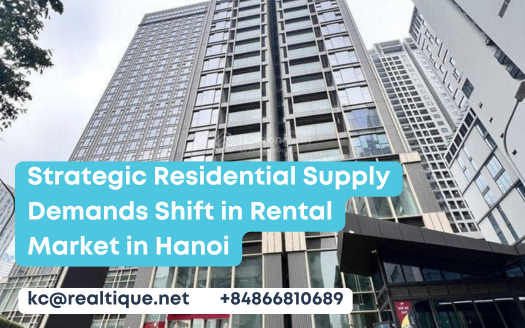Strategic Residential Supply Demands Shift in Rental Market in Hanoi
The rental market is experiencing a notable shift in supply and demand interactions, influenced significantly by an influx of foreign professionals in search of high-quality accommodations. As property owners pivot to meet these changing demands, with over 2,600 new service apartments projected for completion by 2025-2026, it becomes imperative to examine the strategies being employed to attract this discerning demographic. What implications will these changes have for pricing, occupancy rates, and overall market competitiveness as stakeholders adapt to this new environment?
Table of Contents
Although the current supply environment in Hanoi’s rental market appears stagnant, with no new service apartments recorded in Q3 2024, a significant influx of units is anticipated in the near future.
The city plans to introduce over 2,600 service apartments by 2025-2026, primarily focusing on Class A properties.
Two upcoming projects located in Tay Ho and Cau Giay districts are expected to contribute nearly 500 units by Q4 2023. Notably, Tay Ho is projected to account for approximately 65% of the future Class A supply.
Avison Young’s report emphasizes the current lack of new service apartment inventory, highlighting the need for strategic planning to meet the anticipated demand as the market evolves.
Rental Price Analysis
The rental price scenery in Hanoi’s market reflects significant variations driven by property class and location.
As of Q3 2024, Class A apartments command an average monthly rent of approximately $32 (810,000 VND) per square meter, while Class B properties maintain a steadier average of nearly $16 per square meter.
Notably, the lowest recorded rental price is 16.3 million VND at the Oriental Palace project in Tay Ho, contrasted by the highest at $7,550 (about 190 million VND) for a unit in Lotte Center, Ba Dinh.
This disparity highlights the influence of specific projects and districts, revealing a complex pricing environment that property seekers must traverse when considering rental options in Hanoi.
Occupancy Rates Overview
In Hanoi’s rental market, occupancy rates are a critical indicator of demand and overall market health, reflecting the preferences of tenants across different property classes. As reported, Class A properties maintain an impressive occupancy rate of 86%, while Class B properties follow with a rate of 75%. This stability in occupancy suggests a sustained interest, primarily driven by foreign professionals seeking quality living conditions. Below is an overview of the current occupancy rates by property class:
| Property Class | Occupancy Rate |
|---|---|
| Class A | 86% |
| Class B | 75% |
| Average | 80.5% |
The notable demand indicates a favorable trend for landlords and investors in the changing rental environment of Hanoi.
Foreign Investment Impact
Strong occupancy rates in Hanoi’s rental market reflect a growing demand fueled by foreign investment, which plays a significant role in shaping the interactions of the real estate sector.
The influx of foreign direct investment (FDI), reaching nearly $1.5 billion in the past year, has stimulated interest in premium rental properties, particularly Class A apartments. This demand is driven by foreign professionals seeking quality living conditions that align with their lifestyle preferences.
As industrial zones expand, attracting foreign experts, the competition for high-quality rental accommodations intensifies. Consequently, property owners are adapting their arrangements, ensuring that amenities and services meet international standards.
This shift highlights the significant influence of foreign investment on Hanoi’s rental environment, encouraging an energetic and competitive market.
Demand From Professionals
Amidst the energetic environment of Hanoi’s rental market, demand from professionals has emerged as an essential factor influencing rental trends.
The influx of foreign professionals, driven by significant foreign direct investment (FDI), has heightened the demand for quality living accommodations, particularly in Class A properties.
With occupancy rates for these apartments reaching 86%, the appeal of modern amenities and prime locations is evident.
Professionals are increasingly seeking 2-3 bedroom units within the rental range of $1,900 to $3,200, reflecting a preference for comfort and accessibility.
This shift in demand not only shapes pricing strategies but also encourages property developers to enhance alternatives, ensuring that the rental market evolves to meet the expectations of this discerning demographic.
Market Adaptation Strategies
Hanoi’s rental market is witnessing a significant change as property owners and developers implement strategic adaptation measures to align with developing tenant expectations. These strategies include adjusting pricing structures, enhancing amenities, and improving service quality to attract and retain tenants. By focusing on the unique needs of foreign professionals, property owners aim to create more appealing living environments.
| Strategy | Description | Expected Outcome |
|---|---|---|
| Flexible Pricing | Providing discounts for the first year | Increased occupancy rates |
| Enhanced Amenities | Upgrading room standards, adding services | Attracting high-quality tenants |
| Market Monitoring | Regular analysis of tenant preferences | Proactive adjustments to offerings |
| Long-term Lease Incentives | Maintaining stable prices for two years | Encouraging tenant loyalty |
| Community Building Initiatives | Creating social events for residents | Improved tenant satisfaction |
Future Supply Expectations
As property owners adapt to changing tenant expectations, the future supply landscape in Hanoi’s rental market is ready for significant changes.
The city plans to introduce over 2,600 new service apartments by 2025-2026, primarily focusing on Class A properties.
Although no new supply occurred in Q3 2024, upcoming projects in Tay Ho and Cau Giay districts are set to add nearly 500 units by Q4.
Notably, Tay Ho is projected to comprise about 65% of the forthcoming Class A selections.
With a strong demand driven by foreign professionals and significant foreign direct investment, property developers may need to enhance amenities and offer competitive pricing strategies to attract long-term tenants amid shifting market trends.





